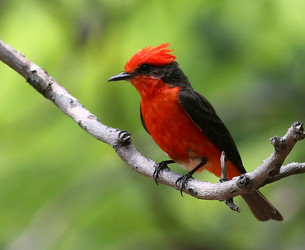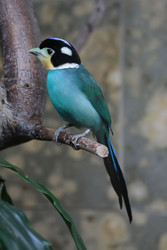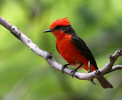Suboscines
John Harshman


This tree diagram shows the relationships between several groups of organisms.
The root of the current tree connects the organisms featured in this tree to their containing group and the rest of the Tree of Life. The basal branching point in the tree represents the ancestor of the other groups in the tree. This ancestor diversified over time into several descendent subgroups, which are represented as internal nodes and terminal taxa to the right.

You can click on the root to travel down the Tree of Life all the way to the root of all Life, and you can click on the names of descendent subgroups to travel up the Tree of Life all the way to individual species.
For more information on ToL tree formatting, please see Interpreting the Tree or Classification. To learn more about phylogenetic trees, please visit our Phylogenetic Biology pages.
close boxDiscussion of Phylogenetic Relationships
Suboscines are divided geographically into New World and Old World clades, Tyrannides and Eurylaimides (Sibley and Ahlquist 1990; Irestedt et al. 2001; Barker et al. 2002, 2004; Chesser 2004; Beresford et al. 2005). The geographic separation is not quite perfect: there is one species of Eurylaimides in the New World, Sapayoa aenigma. New World suboscines can be divided into two clades, Tyranni and Furnarii (Lovette and Bermingham 2000; Irestedt et al. 2001; Barker et al. 2002, 2004; Chesser 2004; note that Sibley and Ahlquist 1990 gave the name Tyranni to a different group).
References
Barker, F. K., G. F. Barrowclough, and J. G. Groth. 2002. A phylogenetic hypothesis for passerine birds; Taxonomic and biogeographic implications of an analysis of nuclear DNA sequence data. Proc. R. Soc. Lond. B 269:295-308.
Barker, F. K., A. Cibois, P. Schikler, J. Feinstein, and J. Cracraft. 2004. Phylogeny and diversification of the largest avian radiation. Proc. Natl. Acad. Sci. USA 101:11040-11045.
Beresford, P., F. K. Barker, P. G. Ryan, and T. M. Crowe. 2005. African endemics span the tree of songbirds (Passeri): Molecular systematics of several evolutionary "enigmas". Proc. R. Soc. Lond. B 272:849-858.
Chesser, R. T. 2004. Molecular systematics of New World suboscine birds. Mol. Phylogen. Evol. 32:11-24.
del Hoyo, J., A. Elliott, and D. A. Christie, eds. 2003. Handbook of the Birds of the World. Vol. 8. Broadbills to Tapaculos. BirdLife International and Lynx Editions, Cambridge, UK and Barcelona.
Harshman, J. 2007. Classification and phylogeny of birds. Pages 1-35 in Reproductive biology and phylogeny of birds (B. G. M. Jamieson, ed.). Science Publishers, Inc., Enfield, NH.
Irestedt, M., J. Fjeldsa, U. S. Johansson, and P. G. P. Ericson. 2002. Systematic relationships and biogeography of the tracheophone suboscines (Aves : Passeriformes). Mol. Phylogenet. Evol. 23:499-512.
Irestedt, M., U. S. Johansson, T. J. Parsons, and P. G. P. Ericson. 2001. Phylogeny of major lineages of suboscines (Passeriformes) analysed by nuclear DNA sequence data. J. Avian Biol. 32:15-25.
Johansson, U. S., M. Irestedt, T. J. Parsons, and P. G. P. Ericson. 2002. Basal phylogeny of the Tyrannoidea based on comparisons of cytochrome b and exons of nuclear c-myc and RAG-1 genes. Auk 119:984-995.
Lanyon, S.M. 1985. Molecular perspective on higher-level relationships in the Tyrannoidea (Aves). Systematic Zoology 34:404–18.
Lovette, I. J., and E. Bermingham. 2000. c-mos variation in songbirds: Molecular evolution, phylogenetic implications, and comparisons with mitochondrial differentiation. Mol. Biol. Evol. 17:1569-1577.
Ridgely, R. S. and G. Tudor. 1994. The Birds of South America. Volume 2. The Suboscine Passerines. University of Texas, Austin.
Sibley, C. G., and J. A. Ahlquist. 1990. Phylogeny and classification of birds, Yale U. Press, New Haven.
Title Illustrations

| Scientific Name | Biatas nigropectus |
|---|---|
| Location | Intervales, São Paulo, Brazil |
| Specimen Condition | Live Specimen |
| Sex | Female |
| Source | White-bearded Antshrike (Biatus nigropectus) |
| Copyright |
© 2004 Arthur Grosset

|
| Scientific Name | Pyrocephalus rubinus |
|---|---|
| Location | Guadalajara, Jalisco, Mexico |
| Specimen Condition | Live Specimen |
| Source | Pyrocephalus rubinus. |
| Source Collection | Flickr |
| Image Use |
 This media file is licensed under the Creative Commons Attribution-NonCommercial-NoDerivs License - Version 2.0. This media file is licensed under the Creative Commons Attribution-NonCommercial-NoDerivs License - Version 2.0.
|
| Copyright | © 2007 Pablo Lèautaud |
| Scientific Name | Psarisomus dalhousiae |
|---|---|
| Location | captive at Wuppertal Zoo |
| Specimen Condition | Live Specimen |
| Source | Zoow_0022 |
| Source Collection | Flickr |
| Image Use |
 This media file is licensed under the Creative Commons Attribution-NonCommercial-NoDerivs License - Version 2.0. This media file is licensed under the Creative Commons Attribution-NonCommercial-NoDerivs License - Version 2.0.
|
| Copyright | © 2007 Nils Schulte-Hunsbeck |
About This Page
Correspondence regarding this page should be directed to John Harshman at
Page copyright © 2013
 Page: Tree of Life
Suboscines.
Authored by
John Harshman.
The TEXT of this page is licensed under the
Creative Commons Attribution-NonCommercial License - Version 3.0. Note that images and other media
featured on this page are each governed by their own license, and they may or may not be available
for reuse. Click on an image or a media link to access the media data window, which provides the
relevant licensing information. For the general terms and conditions of ToL material reuse and
redistribution, please see the Tree of Life Copyright
Policies.
Page: Tree of Life
Suboscines.
Authored by
John Harshman.
The TEXT of this page is licensed under the
Creative Commons Attribution-NonCommercial License - Version 3.0. Note that images and other media
featured on this page are each governed by their own license, and they may or may not be available
for reuse. Click on an image or a media link to access the media data window, which provides the
relevant licensing information. For the general terms and conditions of ToL material reuse and
redistribution, please see the Tree of Life Copyright
Policies.
- First online 02 August 2006
- Content changed 18 September 2007
Citing this page:
Harshman, John. 2007. Suboscines. Version 18 September 2007 (under construction). http://tolweb.org/Suboscines/26445/2007.09.18 in The Tree of Life Web Project, http://tolweb.org/











 Go to quick links
Go to quick search
Go to navigation for this section of the ToL site
Go to detailed links for the ToL site
Go to quick links
Go to quick search
Go to navigation for this section of the ToL site
Go to detailed links for the ToL site